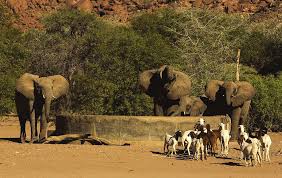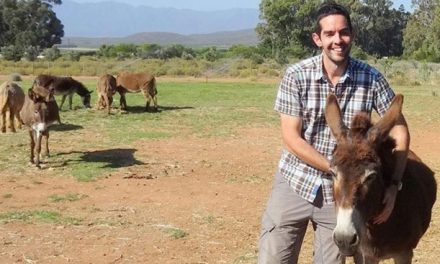
Human-wildlife conflict incidents across the country on the rise – Shifeta

By Clifton Movirongo.
The country has recorded a sudden spike in Human-Wildlife Conflict (HWC) incidents involving elephants, buffaloes and predators reported daily across the country, the environment minister said Wednesday.
According to the Minister of Environment, Forestry and Tourism, Hon Pohamba Shifeta, the incidents are being attending to and he explained that to address HWC requires striking a balance between conservation priorities and the needs of people who live with wildlife.
Shifeta said elephants are wreaking havoc to crops, water infrastructure and property mainly in nine out of the 14 regions. The incidents are specifically reported in the north-western regions comprising the Kunene, Omusati, Ohangwena and Oshikoto Regions as well as regions in the north-eastern part including Kavango West, Kavango East and Zambezi Regions. Reports were also recounted along the Grootfontein commercial farming areas in the Otjozondjupa Region and the Omatjete area in Erongo Region.
“Buffaloes are also reported to be destroying crops in the Zambezi Region, mainly in areas around Lake Liambezi, eastern floodplains as well as areas around Nkasa Rupara, Mudumu and Bwabwata National Parks”, the minister stated, adding that the issue needs to be managed in a way that recognises the rights and development needs of local communities and farmers.
Meanwhile, the far north-western part of Namibia is currently experiencing drought due to low rainfall amounts in received in that vicinity.
“We recently put down three lions in the Omusati Region that has been causing havoc to communities and their livestock in the area. Two crocodiles in the Zambezi Region where also put down and removed from areas they were causing such problems,” the minister said.
Lions also attacked livestock in the Kunene and Omusati Regions, while reports of wild dogs causing conflict have also been notified in some north-eastern regions.
The wild dogs were mainly reported in Salambala Conservancy of the Zambezi Region and in the Kavango East and Otjozondjupa Regions, the minister said.
Intensifying efforts to manage the conflict and mitigation and preventative measures
The Ministry of Environment, Forestry and Tourism (MEFT) plan to drive and chase away elephants to areas where they will not cause problems. The utilisation of helicopters method will be employed at times to aid in fending off the elephants.
The environment minister also emphasised that the process of auctioning off some of the elephants is currently at a stage of discussion and negotiation of contracts, adding that elephant population in specific hotspot areas will be reduced to minimise the conflict.
“Certain animals will be relocated and moved to National Parks or areas where they cannot cause problems. Early warning systems by collaring specific elephants in different herds to monitor their movements and alert communities and farmers will also be conducted and has already been done in some areas. With support of the Game Product Trust Fund, we plan to support communities and farmers in replacing their water tanks being damaged by elephants.”
Farmers and communities are encouraged to make use of wire with tins around crop fields for noise that can fend off wild animals while MEFT staff members in the regions are under instructions to assist the vulnerable.
The practice of chili pepper fences, chili bombs and where possible, the digging of trenches around crop fields is highly advised by the ministry as wild animals like elephants and hippos cannot jump a trench. The use of traditional methods such as drums, vuvuzelas, whips and loud noises are also proven to come in handy.
Guarding of crop fields at night is important and highly encouraged, as long as it is done with care and caution that people do not walk into a herd of wild animals or make wild animals aggressive, the minister said.
MEFT is mapping out wildlife corridors to determine the movement areas of wild animals so as to prevent HWC.
“The wildlife corridor strategy for the Zambezi Region has been finalized and will be launched soon. We are currently working on and finalizing the wildlife corridor strategy for the Kunene, Erongo and Omusati Regions. Kavango West and Kavango East regions will follow,” said Shifeta.
The environment minister also highlighted that his ministry is developing species management plans that will guide the long-term management of species including the management HWC caused by these species.
“With the current good rains in certain parts of the country, the river levels are rising and floods are already experienced in some areas. Crocodiles, hippos, snakes and other wild animals including elephants are also moving with the water. I therefore would like to caution communities and the general public not to take risks that may result in human wildlife conflict or cause loss of human lives,” the minister said.
This comes as during the course of 2020, the environment ministry through the Game Product Trust Fund paid approximately N$ 5,046,801 to individuals, farmers and conservancies for livestock loss, crop damages, injuries to people and loss of life under the HWC Self Reliance Scheme.












































